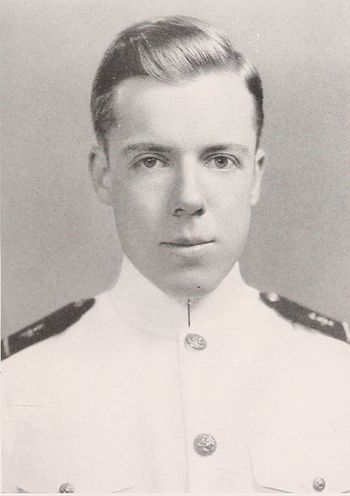FRANCIS B. WEILER, LTJG, USN
Francis Weiler '39
Lucky Bag
From the 1939 Lucky Bag:
FRANCIS BROOKS WEILER
Philadelphia, Pennsylvania
Boo-Boo, Fran, Politician
Several score miles north of our quaint Annapolis lies the gay, wealthy, and well-bred metropolis of Philadelphia. With the Quaker City as a background, and the addition of a brilliant personality, Boo-Boo soon made for himself a host of friends at the Academy. A well-groomed appearance, and the ability to say the right thing at the right time have been the envy and despair of us all. Hailing from a soccer-famous family, he did not take long to prove his mettle with the Plebe squad. In his academic and social pursuits, he has been a shining example of the Teddy Roosevelt "Work hard—play hard" maxim. The result has been that Boo-Boo soon attained the elusive titles of "smoothie" and "savoir."
Soccer 4, 3, 2; Crew Manager 4, 3, 2; "E" Great Guns; King Committee, Chairman; Pep Committee 2; Stunt Committee 1; Reception Committee; Log Staff; Star 4; 3 Stripes.

FRANCIS BROOKS WEILER
Philadelphia, Pennsylvania
Boo-Boo, Fran, Politician
Several score miles north of our quaint Annapolis lies the gay, wealthy, and well-bred metropolis of Philadelphia. With the Quaker City as a background, and the addition of a brilliant personality, Boo-Boo soon made for himself a host of friends at the Academy. A well-groomed appearance, and the ability to say the right thing at the right time have been the envy and despair of us all. Hailing from a soccer-famous family, he did not take long to prove his mettle with the Plebe squad. In his academic and social pursuits, he has been a shining example of the Teddy Roosevelt "Work hard—play hard" maxim. The result has been that Boo-Boo soon attained the elusive titles of "smoothie" and "savoir."
Soccer 4, 3, 2; Crew Manager 4, 3, 2; "E" Great Guns; King Committee, Chairman; Pep Committee 2; Stunt Committee 1; Reception Committee; Log Staff; Star 4; 3 Stripes.
Loss
Francis was a member of the fire control party on USS Houston (CA 30) when that ship was sunk on on March 1, 1942 during the Battle of Sunda Strait. He survived the sinking but died of his wounds on March 26, 1942 in a Japanese POW camp.
Other Information
His parents were listed as next of kin; he was also survived by a brother, James (USNA '31).
Photographs
"Ken Kollmyer and Fran Weiler on Laa Island in the Tawi-Tawi Group, late summer of 1941." Photo from Class of 1939 column in the July-August issue of Shipmate.
Prisoner of War Medal
From Hall of Valor:
Lieutenant, Junior Grade Francis Brooks Weiler (NSN: 0-82596), United States Navy, was captured by the Japanese after the sinking of his ship the U.S.S. HOUSTON (CA-30), on 28 February 1942, and was interned as a Prisoner of War until his death while in captivity.
General Orders: NARA Database: Records of World War II Prisoners of War, created, 1942 - 1947
Action Date: February 28, 1942 - Died in Captivity
Service: Navy
Rank: Lieutenant Junior Grade
Division: Prisoner of War (Japan)
Class Ring
From USSHouston.net
Ring Story: The Long Journey Home
Fran Weiler's ring returns to Annapolis
By Jack Weiler MintzerDuring the Battle of the Java Sea, HOUSTON, the flagship of the U.S. Asiatic Fleet, was sunk by a large Japanese force as she approached the Sunda Strait. On that fateful day, 1 March 1942, the crew of HOUSTON consisted of 1,162 crewmembers. About two‑thirds, 792, were killed in action or missing in action. The 370 survivors were taken prisoner by the Japanese. Of these, 77 died in captivity and 293 would eventually return home. Lieutenant (junior grade) Francis Weiler '39 was one of the unlucky ones.
When HOUSTON went down, a badly wounded Fran made it to shore. He was admitted to the hospital in Pandeglang, Java, on 15 March. Knowing that he did not have long to live, he gave his Naval Academy ring to a Dutch nurse in the hope that she could contact a U.S. naval officer and give it to him. She gave it to a Dutch doctor, and he, either willingly, or otherwise, gave it to a Japanese officer. Sadly, Lieutenant Weiler died of his wounds on 26 March 1942. His gravesite is unknown.
In early November 1942, Gordon Gayle '39, then a Marine captain, was involved in a firefight on Guadalcanal. Four Marine stretcher-bearers paused nearby and one of the Marines, knowing that Captain Gayle was an Academy graduate, handed him a ring that had been taken off the hand of a dead Japanese soldier up on the lines. Captain Gayle promptly put the ring in his pocket and did not look at it until there was a break in the action. When he did examine it, he was surprised to see that it belonged to a classmate. He remembered Francis Weiler as being chairman of the class ring committee.
In the eight months since HOUSTON sank, Lieutenant Weiler's ring traveled more than 3,000 miles from Pandeglang, Java, to Guadalcanal. Its journey was not yet over.
Captain Gayle intended to return the ring to Lieutenant Weiler's family, but felt that his chances of survival were marginal, so he decided to send the ring through official channels. He gave the ring to a fellow officer in his command post. This officer, Captain Swisher, from artillery, was about to return to his unit back in Henderson Field. Gayle asked Swisher to give the ring to the division quartermaster, the usual staff agency to return such items to the United States. Captain Swisher never made it back to his unit at Henderson Field. The 164th U.S. Army Infantry Regiment was nearby and desperately needed forward observers, so Swisher's orders were changed. Tragically, he took a direct hit from a mortar and died an hour later.
It is believed that upon learning of his change of orders, Captain Swisher gave the ring to a Private Charles Stimmel, a radio specialist HQ CO, of the 164th. Again tragedy struck. Private Stimmel was mortally wounded by shell fragments on 23 November 1942 and died within the hour. His best friend was with him when he was hit and Stimmel asked the friend to get his personal effects back to his family in North Dakota. Among the personal effects was Lieutenant Weiler's class ring.
Private Stimmel's father wrote to Dr. George Weiler, Francis Weiler's father, on 1 March 1943, a year to the day that HOUSTON went down, explaining how he came into possession of Fran's ring. The ring was then personally returned to George and Florence Weiler at their home in Germantown, Pennsylvania, by a Marine courier.
Fran's brother, Rear Admiral James B. Weiler '31, USN (Ret.), donated the ring to the Naval Academy Alumni Association in 1961. It is currently on display in the ring collection at Alumni House.
The "Register of Commissioned and Warrant Officers of the United States Navy and Marine Corps" was published annually from 1815 through at least the 1970s; it provided rank, command or station, and occasionally billet until the beginning of World War II when command/station was no longer included. Scanned copies were reviewed and data entered from the mid-1840s through 1922, when more-frequent Navy Directories were available.
The Navy Directory was a publication that provided information on the command, billet, and rank of every active and retired naval officer. Single editions have been found online from January 1915 and March 1918, and then from three to six editions per year from 1923 through 1940; the final edition is from April 1941.
The entries in both series of documents are sometimes cryptic and confusing. They are often inconsistent, even within an edition, with the name of commands; this is especially true for aviation squadrons in the 1920s and early 1930s.
Alumni listed at the same command may or may not have had significant interactions; they could have shared a stateroom or workspace, stood many hours of watch together… or, especially at the larger commands, they might not have known each other at all. The information provides the opportunity to draw connections that are otherwise invisible, though, and gives a fuller view of the professional experiences of these alumni in Memorial Hall.
October 1939
June 1940
November 1940
April 1941

The "category" links below lead to lists of related Honorees; use them to explore further the service and sacrifice of alumni in Memorial Hall.

